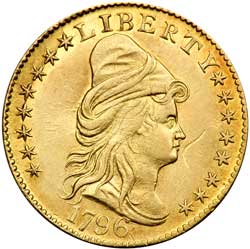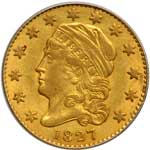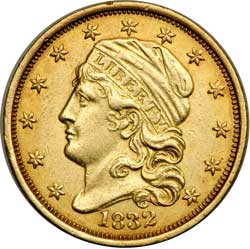
|
Sale 78
January Pre-Long Beach Sale 17.5% BP
| Lot |
Photo |
Description |
Realized |
Lot 1690 |
 |
1796. No Stars BD-2 Rarity 4. BD-2, Rarity-4, 100-125 known. NGC graded AU-55. A very pleasing high grade of our first $2.50. The exposed fields are remarkably clean. Only 963 coins minted. This is a nicely struck example of the No Stars 1796, exhibiting fine detail to many design points, barring only the central part of the eagle�s breast and head where the shield overlaps and the scroll crosses the lower neck. However, most of E PLURIBUS UNUM is clear and readable. The claws on the right are separated and individually seen, which those on the left holding the arrow bunch merge.
Others have pointed out that the Quarter Eagle was of little use in early American commerce, too large for everyday transactions such as store purchases or in farmer�s markets, and too small for the international commerce that favored the gold Half Eagle. From 1796 through the end of the Capped Head to Left Quarter Eagle design in 1834, the coins encompassing "early tenor" gold coinage, the Mint produced approximately 64,262 quarter eagles. This in a quickly growing nation of 12,866,000 people (per the 1830 census)! Pop 2; 28 finer
It is believed -- based upon estimates published by Walter Breen�that only 963 examples were struck of the first quarter eagle. Interestingly, this was of a stand-alone design, a motif that would be discontinued after the 963 coins left the press. Yet there are two die varieties known -- two different reverse dies differing from each other only by minute details. BD-1 is noted for its extended arrows; BD-2 for having "normal" arrows.
Believed to have been designed by Robert Scot, the 1796 quarter eagle utilizes a capped head ("bust") of Liberty facing right. The field is plain, save for the date 1796 below the bust.
The reverse is of the Heraldic Eagle design similar to that used on gold and silver denominations of the period. Adapted from the Great Seal of the United States, the center motif depicts an eagle with a shield on its breast, holding an olive branch and arrows in its talons, while in its beak a ribbon inscribed E PLURIBUS UNUM. A galaxy of stars, with a group of clouds above in an curve extending from one wing to the other. The inscription UNITED STATES OF AMERICA surrounds. There is no mark indicating value, this being consistent with other United States gold denominations at the time.
Of the 963 pieces believed to have been minted, it has been estimated by David Akers, a student of the subject, that perhaps as many as 30 to 40 survive today, although other estimates have been lower, even in the range of 15 to 20 pieces, and recent research describes perhaps 100 to 125 known. Irrespective of which estimate is chosen, the 1796 quarter eagle is, always has been, and will likely continue to be famous as one of the most elusive and one of the most sought-after early American gold coins. Auction sales report that extant specimens tend to be in grades from Very Fine to Extremely Fine, although a few higher condition examples exist. Curiously, the starless obverse field and the cameo-like effect it furnished to the portrait of Liberty resulted in an inordinate number of these coins being used as jewelry. Today it is not uncommon to find examples that once had loops attached to the edge or which have been holed, later plugged, and burnished. Complicating the ease of evaluating and comparing listings of quarter eagles of this design was the general practice to grade these pieces liberally, and also the high rate of resubmissions to grading services. Under the latter procedure, a half dozen listings in population reports might actually represent only a single coin. The aspect of the unknown has always piqued the imagination of numismatists. It presents itself with the 1796 no-stars quarter eagle -- more than for any other design type in the denomination --there are unanswered questions as to how many exist and how the grades of extant pieces are distributed (PCGS # 7645) .
Die State: Obverse, state d, reverse, late state b with both lump break at upper tip of right wing and a second E -- M -- ribbon end.
Estimated Value $80,000 - 90,000.
The Del Valle Collection.
View details and enlarged photos
Check results on similar lots
| Realized
$135,125 |
Lot 1691 |
 |
1796 Stars BD-3 Rarity 5+. PCGS graded AU-55. Well struck on a decent planchet with plenty of mint luster present within the protected areas. We note a mint caused lint mark in the right obverse field, undoubtedly present when struck. Minor adjustment in hair; struck from clashed dies. Only 432 minted for this first year coin.
Similar in many regards to the 1796 No Stars that precedes this With Stars offering, substantial detail expands across the highpoints on this fine example, including exceptional hair and curls, cap detail and eye on Liberty. This follows through to the reverse where E PLURIBUS UNUM is complete except for the first U in UNUM; full horizontal shield lines in the "chief", merged lines in the vertical stripes (as often found on the 1796-1807 heraldic reverse coins. About the only ineffectual imprint was left in a few areas by the recoil of the dies such as the neck feathers (lacking) and left claw, where the claws are merged.
One of the sharper extant 1796 With Stars Quarter Eagles. The 1796 No Stars issue stands as a desirable item to Type collectors. Yet this far more elusive With Stars issue escapes the limelight to an extent, and this is unfortunate. For it is much the rarer of the two types in all grades, and far more difficult to find in choice grade such as here. A definite highlight of the early gold selections in this sale, and a coin we are sure will have no difficulty finding its way into an top-end collection.
Despite its occasional overshadowing by the No Stars type, advanced specialists in early gold realize the rarity of this issue in any grade. Pop 6; 7 finer, 4 in 58, 1 in 61, 1 in 62, 1 in 63 (PCGS # 7647) .
Historic Note: Sometimes forgotten by catalogers and numismatists, the 1796 With stars is itself, like its companion piece having No Stars, an important one-year Type. The only Capped Bust Right, Heraldic Eagle Quarter Eagle that has 16 obverse stars. The government did this at the time of Tennessee's admission to the Union as the sixteenth state on June 1, 1796. Concerns over how the handle the increase in new states caused the Mint by 1797 to abandon the practice of adding a new star to our nation's coinage every time a state joined the Union. From that point on, the use of 13 stars to pay tribute to the original 13 colonies became standard practice for the design and minting of United States coins.
The number of the 1796 Stars Obverse is unrecorded since the early Mint often used dies until they broke regardless of the year on the die. Often the die�s year did not match that on the calendar. Numismatic researchers have long accepted an estimated mintage of just 432 coins for the 1796 With Stars Quarter Eagle. The figure matches the delivery made on January 14, 1797 in fulfillment of warrants placed by gold bullion depositors. Writing in his 2006 book Early U.S. Gold Coin Varieties: A Study of Die States, 1795-1834, John W. Dannreuther estimates that only 40 to 50 of those coins have survived to the present day. (This is fewer than half the number of 1796 No Stars coins left in existence.).
Estimated Value $90,000 - 100,000.
The Del Valle Collection.
View details and enlarged photos
Check results on similar lots
| Realized
$117,500 |
Lot 1692 |
 |
1827. PCGS graded AU-55. Lightly toned on both sides. Only 2,800 struck. This coin is a treasure for any serious buyer of early Capped Bust U.S. gold, it has it much going for it, including a strike with only marginal weakness in the hair waves above Liberty�s brow, only minor weakness in the eagle, original gold luster still evident in quantity on obverse and reverse, bold border dentils, grand eye appeal, and more. Any example that shows original luster can be deemed unusual. Further, only 2,800 were minted, classifying it as a significant rarity. It is by no means the most valuable coin in the series, but certainly from the standpoint of desirability and Choice About Uncirculated quality it stands its ground. Pop 6; 19 finer at PCGS. About 40 to 60 examples known according to PCGS population report.
Design: Capped Head to left, stars surrounding head, date below. Reverse with perched eagle. The modified obverse introduced in 1821 now has a smaller portrait, differently styled than the preceding, and has stars completely around, rather than just to the left and right. The dies were possibly by Robert Scot, who continued as chief engraver, but likely by someone else in the Mint, identity unknown today. The main motif was adapted from that made earlier by John Reich, who worked at the mint from 1807-17 and is responsible for the one-year-only 1808 Quarter Eagle design.
Quarter Eagles of this period were made in limited quantities, there was little call for them by bullion depositors, who told the mint which denominations they required. In the 1820s, the U.S. Mint struck coins to order. Most early 1821-27 Quarter Eagles today show ample evidence of circulation with no luster.
This reverse die carries over from 1825, and was used to strike some pieces of that year. It was later used in the only die pairs identified for the issues of 1826 and 1827. Dies were clashed during the 1826 usage, and a faint remnant of that is visible in the field to the left of the eagle's beak. No other artifacts of the clash are seen.
Estimated Value $22,000 - 24,000.
View details and enlarged photos
| Unsold |
Lot 1693 |
 |
1832 BD-1 Rarity 4. PCGS graded AU-53. Well struck and problem-free. Just normal light handling marks for the grade. Delicate antique toning surrounds the borders. This variety was cataloged as Breen-1 in his earlier monographs from the 1960s, the only Quarter Eagle variety of the date. It represents the final Quarter Eagle variety struck at the first United States Mint building in Philadelphia. In early January of 1833, the second Mint building was ready for occupation after some delay. Thus, the coinage of 1832, from half cents through half eagles, represent the end of an important period in United States numismatics. The 1833 Mint Report, submitted on January 19th of that year by Mint Director Samuel Moore, recorded the mintage of 1832 quarter eagles as 4,400 coins, or $11,000 face value. Today, we estimate that 80 to 100 are known, making this year Rarity-4. In the time period covered by Dannreuther�s guide book to early U.S. gold coins, 1990 to 2005, there were reported to be 70 auction appearances of the 1832 Quarter Eagle.
This handsome AU53 example is a sharply struck with the exception of the highest hair wave above the ear; attractive light gold color and lightly abraded surfaces, just enough to keep it out of a choicer category. The opportunity to bid on this issue in any grade is an valuable one, and it is even more important given the respected old-time coin dealer from whom it came. Pop 8; 31 finer (PCGS # 7672) .
Estimated Value $10,000 - 12,000.
Ex: Purchased from Abner Kreisberg in the 1970's The Del Valle Collection.
View details and enlarged photos
Check results on similar lots
| Realized
$16,450 |
|
|